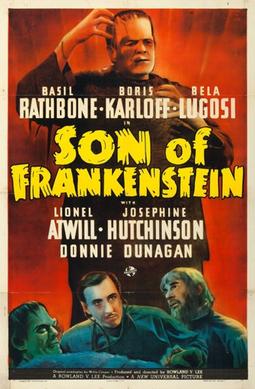
Son of Frankenstein is a 1939 American horror film directed by Rowland V. Lee and starring Basil Rathbone, Boris Karloff and Bela Lugosi. The film is the third in Universal Pictures' Frankenstein series and is the follow-up to the 1935 film Bride of Frankenstein. Son of Frankenstein stars Rathbone as Baron Wolf von Frankenstein who, with his wife Elsa and son Peter, returns to his late father's estate. Near the castle lives Ygor, a crazed blacksmith whose neck was broken in an unsuccessful hanging attempt. Among the castle's remains, Frankenstein discovers the remains of the Monster and decides to try to save his family name by resurrecting the creature to prove his father was correct. He finds, however, the Monster only responds to Ygor's commands.

The Invisible Man Returns is a 1940 American horror science fiction film directed by Joe May. The film stars Cedric Hardwicke, Vincent Price, Nan Grey and John Sutton. The film is a sequel to the 1933 film The Invisible Man, and the second film in the Invisible Man film series, loosely based on the novel by H. G. Wells. The film is about Sir Geoffrey Radcliffe (Price) who is condemned for a murder he did not commit, which leads to him begging Dr. Frank Griffin (Sutton) to inject him with the invisibility serum despite Griffin's warning that the serum will drive him mad.

The Black Cat is a 1941 American comedy horror and mystery film directed by Albert S. Rogell and starring Basil Rathbone. The film was a stylistic hybrid, inspired by comedy "Old Dark House" films of the era as well as the 1843 short story "The Black Cat" by Edgar Allan Poe. It stars Basil Rathbone as Montague Hartley, the head of a greedy family who await the death of Henrietta Winslow so that they can inherit her fortune. When she is found murdered, an investigation begins into who might be the culprit. Alongside Rathbone and Loftus, the film's cast includes Hugh Herbert, Broderick Crawford, and Bela Lugosi.

House of Frankenstein is a 1944 American horror film starring Boris Karloff, Lon Chaney Jr. and John Carradine. It was directed by Erle C. Kenton and produced by Universal Pictures. Based on Curt Siodmak's story "The Devil's Brood", the film is about Dr. Gustav Niemann, who escapes from prison and promises to create a new body for his assistant Daniel. Over the course of the film, they encounter Count Dracula, the Wolf Man and Frankenstein's monster. The film is a sequel to Frankenstein Meets the Wolf Man (1943).

House of Dracula is a 1945 American horror film released and distributed by Universal Pictures. Directed by Erle C. Kenton, the film features several Universal Horror properties meeting as they had done in the 1944 film House of Frankenstein. The film is set at the castle home of Dr. Franz Edelmann, who is visited first by Count Dracula and later by Larry Talbot, the Wolf Man, who are trying to cure their vampirism and lycanthropy, respectively. Talbot is eventually cured, which leads him to discover the body of Frankenstein's monster in a cave below the base of the castle. Edelemann takes the monster's body back to his laboratory but finds Count Dracula has awakened and by attacking his assistants, he captures Edelmann and forces a reverse blood transfusion, which gives Edelmann a split personality and makes him a killer.

Anne Gwynne was an American actress who was known as one of the first scream queens because of her numerous appearances in horror films. Gwynne was also one of the most popular pin-ups of World War II. She is the maternal grandmother of actor Chris Pine.

The Mad Ghoul is a 1943 American horror film directed by James Hogan and starring Turhan Bey, Evelyn Ankers, and David Bruce, and featuring George Zucco, Robert Armstrong, and Milburn Stone. The film is about the scientist Dr. Alfred Morris and his assistant Ted Allison. Morris, who is obsessed with an ancient Mayan life-preserving process to the point of madness, has fallen in love with Allison's girlfriend, the concert singer Isabel Lewis. Morris decides to use Allison for his eternal-life experiments, transforming him into a zombie who slowly recalls his past life, but is unaware of his undead status.
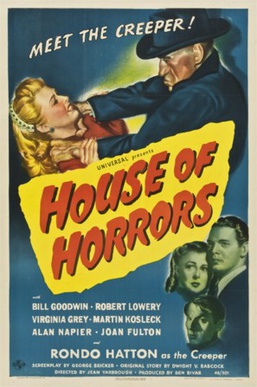
House of Horrors is a 1946 American horror film released by Universal Pictures, starring Rondo Hatton, Martin Kosleck and Robert Lowery. The screenplay was by George Bricker from an original story by Dwight V. Babcock. A sculptor enlists the assistance of a madman to kill his critics.
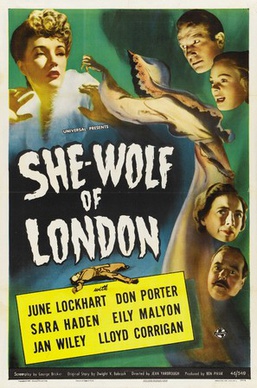
She-Wolf of London is a 1946 American mystery and horror film directed by Jean Yarbrough. It stars June Lockhart and Don Porter. The film is set in London in the early 20th century, where a series of murders have recently occurred. An aunt then tells an innocent young lady that the blood of a werewolf runs in her family and that she is responsible for the deaths. The woman then immediately ends her engagement, leading to her partner to begin investigating the strange case on his own.

Murders in the Rue Morgue is a 1932 American horror film directed by Robert Florey, based on Edgar Allan Poe's 1841 short story "The Murders in the Rue Morgue". The plot is about Doctor Mirakle, a carnival sideshow entertainer and scientist who kidnaps Parisian women to mix their blood with that of his gorilla, Erik. As his experiments fail because of the quality of his victims' blood, Mirakle meets with Camille L'Espanye, and has her kidnapped and her mother murdered, leading to suspicion falling on Camille's fiance, Pierre Dupin, a medical student who has already become interested in the earlier murders.

Captive Wild Woman is a 1943 American horror film directed by Edward Dmytryk. The film stars Evelyn Ankers, John Carradine, Milburn Stone, and features Acquanetta as Paula, the Ape Woman. The film involves a scientist, Dr. Sigmund Walters, whose experiments turn a female gorilla named Cheela into a human by injecting the ape with sex hormones and via brain transplants.
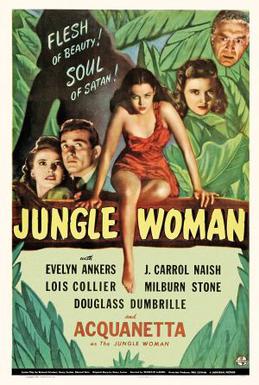
Jungle Woman is a 1944 American horror film directed by Reginald LeBorg. The film stars Evelyn Ankers, J. Carrol Naish, Samuel S. Hinds, Lois Collier and Acquanetta. Jungle Woman was the second film in Universal's Cheela, the Ape Woman series, preceded by Captive Wild Woman.

The Brute Man is a 1946 American horror thriller film starring Rondo Hatton as the Creeper, a murderer seeking revenge against the people he holds responsible for the disfigurement of his face. Directed by Jean Yarbrough, the film features Tom Neal and Jan Wiley as a married pair of friends the Creeper blames for his deformities. Jane Adams also stars as a blind pianist for whom the Creeper tries to raise money for an operation to restore her vision. The film is a prequel to House of Horrors (1946).
Shock Theater is a package of 52 pre-1948 classic horror films from Universal Studios released for television syndication in October 1957 by Screen Gems, the television subsidiary of Columbia Pictures. The Shock Theater package included Dracula, Frankenstein, The Mummy, The Invisible Man and The Wolf Man as well as a few non-horror spy and mystery films. A second package, Son of Shock, was released for television by Screen Gems in 1958, with 20 horror films from both Universal and Columbia.
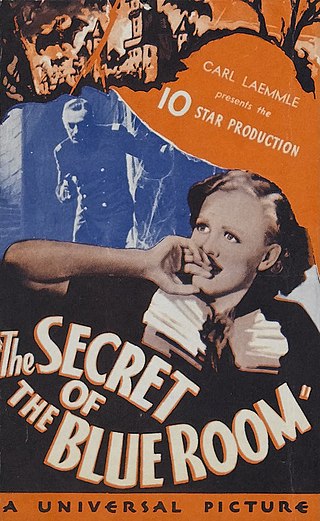
The Secret of the Blue Room is a 1933 American pre-Code mystery film directed by Kurt Neumann and starring Lionel Atwill, Gloria Stuart, Paul Lukas, and Edward Arnold. A remake of the German film Geheimnis des blauen Zimmers (1932), it concerns a group of wealthy people who stay at a European mansion that features a blue room that is said to be cursed, as everyone who has stayed there has died shortly after. Three people suggest a wager that each can survive a night in the blue room.

The Mystery of Marie Roget is a 1942 mystery film starring Patric Knowles. The story was adapted from the short story "The Mystery of Marie Rogêt" written by Edgar Allan Poe in 1842. The film, directed by Phil Rosen and produced by Universal Pictures, is set in 1889.

The Cat Creeps is a 1946 American film directed by Erle C. Kenton and starring Noah Beery Jr., Lois Collier, and Paul Kelly. It follows a journalist and his photographer who attempt to research an unsolved death and locate a missing fortune, with the help of a black cat that appears to be possessed by the spirit of a dead woman.

The Mad Doctor of Market Street is a 1942 American horror film produced by Universal Pictures starring Lionel Atwill. The film was a low-budget project that utilized the studio's contract players and gave rising director Joseph H. Lewis an opportunity to demonstrate his versatility with little production money.

The House of Fear is a 1939 American mystery film directed by Joe May and starring William Gargan, Irene Hervey and Dorothy Arnold.
Dracula is a film series of horror films from Universal Pictures based on the 1897 novel Dracula by Bram Stoker and its 1927 play adaptation. Film historians have had various interpretations over which projects constitute being in the film series; academics and historians finding narrative continuation between Dracula (1931) and Dracula's Daughter (1936), while holding varying opinions on whether Son of Dracula (1943), House of Frankenstein (1944) and House of Dracula (1945) are part of the series. Author and academic Gary Don Rhodes stated the all the mentioned films would require an audience to be familiar with Count Dracula, portrayed by Bela Lugosi, and the various character traits the actor established in the original 1931 film.


















